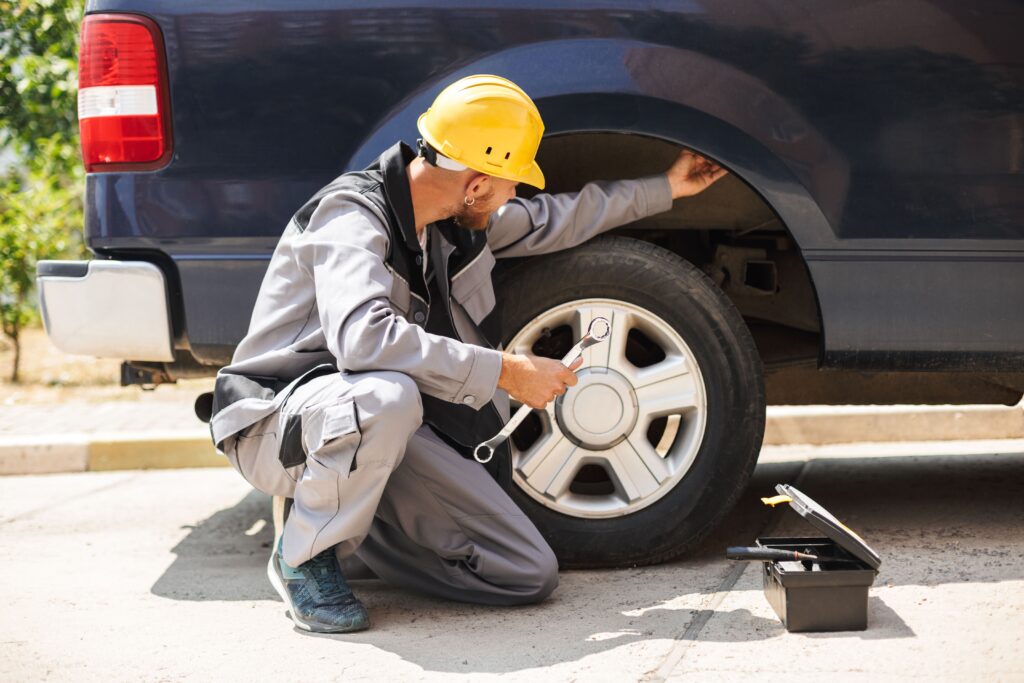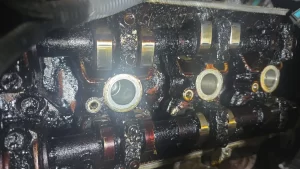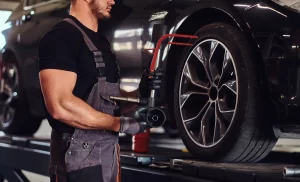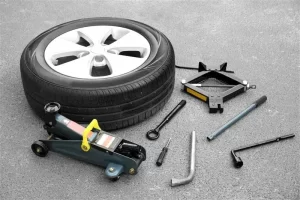Experiencing a flat tire can be frustrating and stressful, especially if you are on the road or in a hurry. However, knowing how to change a tire can save you time and keep you safe. This guide will provide you with everything you need to know before changing a tire, including essential safety measures,tyre repair service, tools, step-by-step instructions, and when to seek professional help.
1. Ensure Safety First
Before attempting to change a tire, your safety should be your top priority. Taking proper precautions can prevent accidents and injuries. Here’s what you need to do:
Find a Safe Location
- As soon as you notice a flat tire, do not panic. Slowly reduce your speed and look for a level, straight stretch of road with a wide shoulder, a parking lot, or a designated pull-off area.
- Avoid stopping on curves, hills, or near busy traffic, as this can be dangerous.
- If you are on a highway, drive slowly to the nearest exit rather than stopping on the shoulder if possible.
Turn on Your Hazard Lights
- The moment you realize you have a flat tire, turn on your hazard lights to alert other drivers that you are slowing down and may be stopping.
- It’s especially crucial at night or in bad weather conditions where visibility is low.
Apply the Parking Brake
- After stopping, engage your parking brake to prevent your vehicle from rolling while changing the tire.
- Please add an extra layer of safety, especially if you’re on a slight incline.
Use Wheel Wedges
- Place wheel wedges (or heavy objects like bricks or rocks) behind the tires opposite to the flat one.
- It helps prevent movement while the car is lifted.
Avoid Working on the Roadside Without Protection
- Set up reflective warning triangles or flares a few meters behind your vehicle to warn other drivers.
- Wearing a reflective safety vest can also help you be more visible, especially at night.
2. Gather Essential Tools
Changing a tire requires a few key tools, and it’s good practice to keep them in your car at all times. Here’s what you’ll need:
Must-Have Tools
- Spare Tire: Ensure it is properly inflated and in good condition.
- Car Jack: Used to lift the vehicle off the ground.
- Lug Wrench: For loosening and tightening the lug nuts.
- Owner’s Manual: Provides specific instructions related to your vehicle’s tire-changing procedure.
Additional Useful Items
- Flashlight and Extra Batteries: Essential for nighttime tire changes.
- Gloves: Helps keep your hands clean and protected.
- Tire Pressure Gauge: Ensures the spare tire is properly inflated before driving.
- Wooden Block (2″x6″): Placing this under the jack provides extra stability on soft or uneven ground.
3. Step-by-Step Guide to Changing a Tire
Now that you’re prepared, follow these steps to replace your flat tire safely:
Step 1: Remove the Hubcap or Wheel Cover
- If your car has a hubcap covering the lug nuts, use the flat end of the lug wrench or a screwdriver to pry it off carefully.
Step 2: Loosen the Lug Nuts
- Using the lug wrench, turn each lug nut counterclockwise about a half-turn to loosen them.
- Do not fully remove them yet—this should only be done once the car is lifted.
Step 3: Position the Jack and Lift the Vehicle
- Locate the jack point near the flat tire (refer to your vehicle manual for the exact location).
- Place the jack securely and pump or crank it until the tire is about 6 inches off the ground.
Step 4: Remove the Lug Nuts and Tire
- Fully unscrew the loosened lug nuts and keep them in a safe place so they don’t roll away.
- Carefully pull the flat tire straight off the wheel bolts and set it aside
Step 5: Mount the Spare Tire
- Align the spare tire with the wheel bolts and push it into place.
- Hand-tighten the lug nuts as much as possible before lowering the vehicle.
Step 6: Lower the Vehicle and Tighten the Lug Nuts
- Lower the car until the spare tire touches the ground, but don’t put full weight on it yet.
- Use the lug wrench to tighten the lug nuts in a crisscross (star) pattern to ensure even pressure.
Step 7: Fully Lower the Car and Double-Check Everything
- Lower the vehicle completely and remove the jack.
- Ensure all lug nuts are tightened securely to prevent wobbling while driving.
- Reattach the hubcap if applicable.
4. Post-Tire Change Considerations
After installing the spare tire, there are a few more things you need to do:
Check the Tire Pressure
- Use a tire pressure gauge to check if the spare tire is inflated properly.
- If it’s underinflated, drive slowly to the nearest auto service to fill it up.
Drive Cautiously and Replace the Spare ASAP
- Spare tires, especially donuts (temporary spares), are not designed for long-term use.
- Drive at moderate speeds and visit a tire repair shop or tire fitting service in Adelaide to get a proper replacement as soon as possible.
5. Preventative Measures to Avoid Flat Tires
To reduce the chances of dealing with a flat tire in the future, consider these maintenance tips:
Regular Tire Inspections
- Check your tires for cracks, bulges, or uneven wear at least once a month.
- Look for nails, glass, or sharp objects that may have punctured your tires.
Maintain Proper Tire Pressure
- Keeping your tires inflated to the recommended PSI improves safety, fuel efficiency, and tire lifespan.
- Many gas stations and car repair shops provide free air pressure checks.
Rotate Your Tires Regularly
- Tire rotation ensures even tread wear, reducing the risk of premature flat tires.
- Typically, you should rotate your tires every 5,000–7,500 miles.
When to Call the Experts: The Importance of Professional Tyre Fitting Services Adelaide with Sai Car Mechanic
If you find yourself stranded with a flat tire, get help from a professional’s safest and most efficient solution. Sai Car Mechanic offers expert tire repair, replacement, and tyre fitting services Adelaide that ensure your vehicle is road-ready with minimal hassle.
Professional Tyre Fitting for Maximum Safety
- Their skilled technicians ensure that your new tires are correctly mounted, balanced, and inflated, improving vehicle performance and safety.
- A professional fitting prevents common issues like uneven tire wear, loose lug nuts, or poor road grip.
Wide Range of High-Quality Replacement Tyres
- If your tire is beyond repair, we offer a variety of premium and budget-friendly tires to suit different vehicles and driving conditions.
- They supply trusted brands with warranties, ensuring durability and long-term performance.
Mobile Tyre Fitting for Convenience
- Don’t have time to visit a workshop? We offer mobile tire fitting services, so they come to your home, workplace, or roadside location.
- It saves you the trouble of driving on a damaged tire or waiting for a tow truck.
Comprehensive Vehicle Safety Check
- Unlike a DIY tire change, a professional mechanic inspects your vehicle for hidden issues like:
- Wheel misalignment
- Brake system problems
- Worn-out suspension components
- Detecting these issues can prevent future breakdowns and costly repairs.
Transparent Pricing and Affordable Services
- Many people hesitate to call a professional because of cost concerns, but Sai Car offers competitive pricing with no hidden charges.
- Their services are cost-effective, ensuring you get high-quality artistry without breaking the bank.
Expert Advice and Customer Support
- Which type of tire is best for your vehicle? Our experienced team provides expert recommendations based on your driving habits, vehicle type, and budget.
- They offer honest advice on whether your tire needs a repair or full replacement, helping you make an informed decision.
- Their friendly customer support ensures you receive clear explanations, prompt responses, and reliable service every time you need assistance.
Fast and Reliable Service
- Nobody wants to be stuck on the roadside for hours. Sai car mechanics are known for quick response times and efficient service, minimizing your downtime.
- Their professionals arrive fully equipped, ready to change or repair your tire on the spot.
- Whether it’s at your home, workplace, or in the middle of the road, their team ensures hassle-free and efficient service.
Conclusion
Knowing how to change a tire is an essential skill that can save you time and trouble in emergencies. However, prioritizing safety, carrying the right tools, and seeking professional help when necessary are crucial aspects of responsible vehicle maintenance.
By following these steps and practicing regular tire maintenance, you can minimize the chances of getting stranded due to a flat tire.






